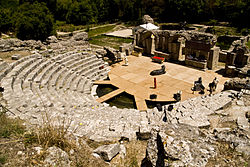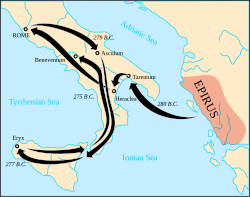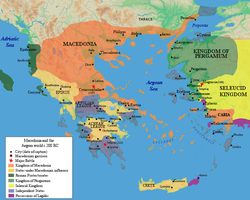Chaonians
The Chaonians (Ancient Greek: Χάονες [Cháones] Error: {{Lang}}: text has italic markup (help)) were an ancient Greek tribe that lived in the region of Epirus that is today part of northwestern Greece and southern Albania.[1][2] It was part of the northwestern group of Greek tribes together with the Molossians and the Thesprotians.[1]
Name
The Greek names "Chaonia" (Χαονία) and "Chaones/Chaonians" (Χάονες) both come from "Chaon" (Χάων, *χαϝ-ών) meaning "place with gorges".[3]
History
The Chaonians are first mentioned by the Greek historian Thucydides in the 5th century BC.[4]
The Greek historian Strabo says that the Chaonians and the Molossians were the most famous tribes of Epirus, because they once ruled all of Epirus.[5]
The Periplus of Pseudo-Scylax refers to the Chaonians as separate from the Illyrians.[6]
The Greek historian Polybius says that the Illyrians raided the Chaonian city of Phoenice in 230 BC.[7] Many Italian traders who were at the city when the raid happened were killed or enslaved resulting in the Roman Republic starting the Illyrian Wars the next year.[7]
Politics and culture
The Chaonians were settled Kata Komas (Ancient Greek: Κατά Κώμας), meaning in a group of villages, and established a tribal state in the 5th century BC.[8]
The Greek historian Thucydides says that their leaders were chosen yearly and names two such leaders: Photius and Nikanor.[9]
They were connected to other Greek tribes in Epirus (Ancient Greek: φυλαί [phylae] Error: {{Lang}}: text has italic markup (help)) such as the Thesprotians and Molossians.[10] The Chaonians joined the Epirote League, a federation of Greek tribes founded in 325/320 BC that ruled Epirus until the Romans conquered the region in 170 BC.[11]
The Chaonians participated in the ancient Olympic games and festivals where only Greeks were allowed to attend.[2][12][13]
List of Chaonians
- Photius and Nicanor, leaders of the Chaonians in the Peloponnesian War (circa 431–421 BC).
- Doropsos Δόροψος, theorodokos in Epidauros (circa 365 BC).[14]
- Antanor (son of Euthymides), proxenos in Delphi (325–275 BC).[15]
- Peukestos, proxenos in Thyrrheion, Acarnania (3rd century BC) -πητοῦ Χάονα Πευκεστόν, Σωτι-.[16]
- Myrtilos, officer who gave proxeny decree to Boeotian Kallimelos (late 3rd century BC).[17]
- Boiskos (son of Messaneos), prostates (late 3rd century BC)[18] (the Greek word prostates means "ruler"[19]).
- Lykidas (son of Hellinos), prostates (circa 232–168 BC).[20]
- -tos (son of Lysias), winner in Pale (wrestling) Panathenaic Games (194/193 BC).[21]
- Charops, father of Machatas, father of Charops the Younger - philoroman politicians (2nd century BC).[22]
Chaonians Media
Chaonians joined Pyrrhus of Epirus during his Italian campaign.
Distribution of Greek dialects in the classical period, with Epirus and Chaonia in the far northwest, shown speaking Northwest Greek.
References
Citations
- ↑ 1.0 1.1 Encyclopædia Britannica ("Epirus") 2013; Hammond 1998, p. 75; Hammond 1994, pp. 430, 434; Hammond 1982, p. 284; Wilkes 1995, p. 104; Hadeli 2020, pp. 11, 41.
- ↑ 2.0 2.1 Hatzopoulos 2007, "Since only Hellenes participated in the Panhellenic sacrifices and contests, it is obvious that the theoroi visited only communities which considered themselves and were considered by the others as Greek. [...] Similarly the [theorodokoi] section Epirus lists the states of Pandosia, Kassopa, Thesprotoi, Poionos, Korkyra, Chaonia, Artichia, Molossoi, Ambrakia, Argos (of Amphilochia). Of these the Elean colony of Pandosia and the Corinthian colonies of Korkyra and Ambrakia represent the southern Greek element, while Kassopa, the Thesprotoi, the Molossoi, Chaonia and Argos the "native" Epirote one. (Nothing is known of Poionos and Artichia). The important point is that colonial cities, Epirote cities and Epirote ethne, republican and monarchical alike, are considered equally Greek and invited to the great panhellenic sacrifices at Epidauros."
- ↑ Georgiev 1981, p. 156.
- ↑ Stocker 2009, p. 209.
- ↑ Strabo. The Geography, 7.7.5.
- ↑ Hammond 1994, p. 433.
- ↑ 7.0 7.1 Errington 1989, pp. 81–106.
- ↑ Nielsen 1997, p. 14.
- ↑ Thucydides. History of the Peloponnesian War, 2.80.5.
- ↑ Hammond 1982, p. 266.
- ↑ Franke 1989, p. 459.
- ↑ Davies 2002, p. 247.
- ↑ Hansen 2004, p. 106.
- ↑ IG IV2,1 95 col I.1 Line 29.
- ↑ FD III 4:409 II.7
- ↑ IG IX,12 2:243.
- ↑ Cabanes 1976, p. 547: Appendice Epigraphique, 16.
- ↑ SEG 38:468.
- ↑ Liddell & Scott 1940, προστάτης.
- ↑ SEG 48:683 (Manumission Record).
- ↑ IG II2 2313 col II.8 Line 34.
- ↑ Toynbee 1965, p. 472.
- ↑ De Maria, Bogdani & Giorgi 2017, p. 56.
Sources
- Cabanes, Pierre (1976). L'Épire, de la mort de Pyrrhos à la conquête romaine (272–167 av. J.C.) (in français). Paris: Les Belles Lettres.
- Davies, J. K. (2002). "A Wholly Non-Aristotelian Universe: The Molossians as Ethnos, State, and Monarchy". In Brock, Roger (ed.). Alternatives to Athens: Varieties of Political Organization and Community in Ancient Greece. Oxford University Press. ISBN 0199258104.
- Encyclopædia Britannica ("Epirus") (2013). "Epirus". Encyclopædia Britannica, Inc. Retrieved 1 July 2013.
- Errington, Robert Malcolm (1989). "CHAPTER 4 ROME AND GREECE TO 205 B.C.". In Astin, A. E.; Walbank, F. W.; Frederiksen, M. W.; Ogilvie, R. M. (eds.). The Cambridge Ancient History: Rome and the Mediterranean to 133 B.C. Vol. VIII (2nd ed.). Cambridge: Cambridge University Press. pp. 81–106. ISBN 0-521-23448-4.
- Franke, P. R. (1989). "CHAPTER 10 PYRRHUS". In Astin, A. E.; Walbank, F. W.; Frederiksen, M. W.; Ogilvie, R. M.; Drummond, A. (eds.). The Cambridge Ancient History: The Rise of Rome to 220 BC. Vol. VII, Part 2. Cambridge: Cambridge University Press. pp. 456–485. ISBN 0-521-23446-8.
- Funke, Peter; Moustakis, Barbara; Hochschulz (2004). "Epeiros". In Mogens Herman Hansen; Thomas Heine Nielsen (eds.). An Inventory of Archaic and Classical Poleis. Oxford: Oxford University Press. pp. 338–350. ISBN 0-19-814099-1.
- Georgiev, Vladimir Ivanov (1981). Introduction to the History of the Indo-European Languages. Bulgarian Academy of Sciences. ISBN 978-953-51-7261-1.
- Hadeli, Vassiliki (2020) (in el). Chaones. Ioannina: University of Ioannina. https://olympias.lib.uoi.gr/jspui/handle/123456789/30713?locale=en.
- Hammond, Nicholas Geoffrey Lemprière (1998). Philip of Macedon. London: Duckworth. ISBN 0-7156-2829-1.
- Hammond, Nicholas Geoffrey Lemprière (1994). "CHAPTER 9d. ILLYRIANS AND NORTH-WEST GREEKS". In Lewis, David Malcolm; Boardman, John; Hornblower, Simon; Ostwald, M. (eds.). The Cambridge Ancient History: The Fourth Century B.C. Vol. VI (2nd ed.). Cambridge: Cambridge University Press. pp. 422–443. ISBN 0-521-23348-8.
- Hammond, Nicholas Geoffrey Lemprière (1982). "CHAPTER 40 ILLYRIS, EPIRUS AND MACEDONIA". In Boardman, John; Hammond, Nicholas Geoffrey Lemprière (eds.). The Cambridge Ancient History: The Expansion of the Greek World, Eighth to Sixth Centuries B.C. Vol. III, Part 3 (2nd ed.). Cambridge: Cambridge University Press. pp. 261–285. ISBN 0-521-23447-6.
- Hansen, Mogens Herman (2004). "Theorodokoi as Evidence for Polis Identity". In Mogens Herman Hansen; Thomas Heine Nielsen (eds.). An Inventory of Archaic and Classical Poleis. Oxford University Press. pp. 103–106. ISBN 0-19-814099-1.
- Hatzopoulos, Miltiades B. (2007) [2002]. "Perception of the Self and the Other: The Case of Macedonia". Ancient Macedonia VII: Macedonia from the Iron Age to the Death of Philip II. Papers Read at the Seventh International Symposium Held in Thessaloniki, October 14–18, 2002. Thessaloniki: Institute for Balkan Studies. pp. 51–66. ISBN 978-9-6073874-2-4.
- Liddell, Henry George; Scott, Robert (1940). A Greek-English Lexicon. Oxford: Clarendon Press.
- Nielsen, Thomas Heine (1997). Yet More Studies in the Ancient Greek Polis. Stuttgart: Franz Steiner Verlag. ISBN 3-515-07222-5.
- Stocker, Sharon R. (2009). Illyrian Apollonia: Toward a New Ktisis and Developmental History of the Colony.
- Toynbee, Arnold Joseph (1965). Hannibal's Legacy: The Hannibalic War's Effects on Roman Life. Oxford: Oxford University Press.[dead link]
- Wilkes, John (1995) [1992]. The Illyrians. Oxford: Blackwell Publishers Limited. ISBN 0-631-19807-5.
Further reading
- Bogdani, Julian (2012). "Genesi urbana e organizzazione del territorio nella Caonia di età classica ed ellenistica". In Enrico Giorgi, Julian Bogdani (ed.). Il territorio di Phoinike in Caonia: archeologia del paesaggio in Albania meridionale. Ante Quem. pp. 355–395. ISBN 9788878490796.
- Gjongecaj, Shpresa (2013) [2007]. "Le monnayage des Chaones". In Liampi, K. (ed.). Proceedings of the 1st International Conference: Numismatic History and Economy in Epirus During Antiquity (in français). Ioannina: Lydia Lithos, Society for the Study of Numismatics and Economic History (University of Ioannina). ISSN 1792-3743.
- Hammond, Nicholas Geoffrey Lemprière (1997a). "The Tribal Systems of Epirus and Neighbouring Areas down to 400 B.C.". In Sakellariou, Michael B. (ed.). Epirus: Four Thousand Years of Greek History and Civilization. Athens: Ekdotike Athenon. ISBN 960-213-377-5.
- Hammond, Nicholas Geoffrey Lemprière (1997b). "The Entry of Epirus into the Greek World, 400-330 B.C.". In Sakellariou, Michael B. (ed.). Epirus: Four Thousand Years of Greek History and Civilization. Athens: Ekdotike Athenon. ISBN 960-213-377-5.
- Hammond, Nicholas Geoffrey Lemprière (1991). "The "Koina" of Epirus and Macedonia". Illinois Classical Studies. 16 (1/2): 183–192. ISSN 0363-1923. JSTOR 23064357.
- Hammond, Nicholas Geoffrey Lemprière (1967). Epirus: The Geography, the Ancient Remains, the History and Topography of Epirus and Adjacent Areas. Oxford: Clarendon Press.
- Hatzopoulos, Miltiades B. (1997). "The Boundaries of Hellenism in Epirus during Antiquity". In Sakellariou, Michael B. (ed.). Epirus: Four Thousand Years of Greek History and Civilization. Athens: Ekdotike Athenon. pp. 140–145. ISBN 960-213-377-5.
- Hornblower, Simon (2002). The Greek World, 479-323 BC. New York and London: Routledge. ISBN 0-415-16326-9.
- Oliver, James H. (1947). "Review of L'Acropoli di Butrinto". The American Journal of Philology. 68 (1): 101–105. doi:10.2307/291069. ISSN 0002-9475. JSTOR 291069.
- Sakellariou, Michael (1997). "The Boundaries of Hellenism in Epirus During Antiquity". Epirus: 4000 Years of Greek History and Civilization. Athens: Ekdotike Athenon. ISBN 978-9-60-213371-2.








